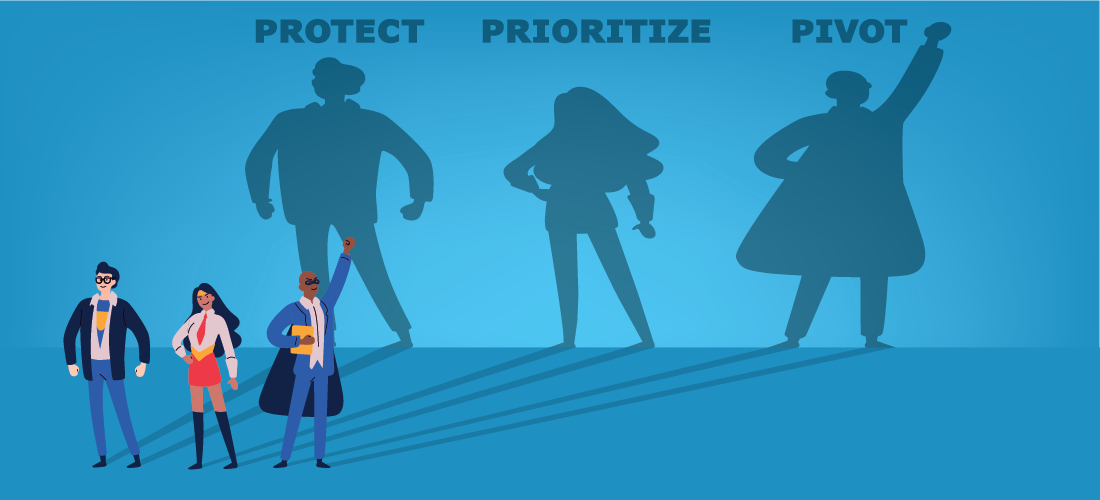Wow, what a ride! For those of you connected to talent development, you know what we’re talking about – and for those of you in other disciplines, you can probably relate. A few weeks ago, it was business as usual. We were free to travel where we pleased, people were still coming into the workplace, and we were still thinking about learning experiences the same way we’ve been thinking about them over the past several years. In person was fine, and in many cases, preferred. What a difference a global crisis makes.
Today, most of us are tucked away at home in makeshift offices with kids, pets, and about a million other distractions in the background. But it’s not just our people who have needed to think differently about how they work; learning and development professionals all over the world have had to adjust how we deliver learning experiences when we can’t bring people together in the same room. In-person learning might be on hold, but the need to engage our people is not. And you can’t quarantine your strategy.
From a business perspective, we continue to hear from our clients that they are laser focused on these three things:
- Protect. What do we need to protect to ensure our business continuity in the coming weeks and months?
- Prioritize. We know we can’t put our strategy on hold, so what is mission critical for us to deliver in the coming weeks and months?
- Pivot. Given that we can’t bring people together, how might we engage our people in different ways to deliver on our business priorities?
It’s Time to Pivot Your L&D and Think Bigger
To address that third point, talent leaders with a responsibility for curating or creating programs are spending a tremendous amount of energy and all reacting a bit differently to the current situation. Some talent leaders have been in a minor – or even major – panic because most or all their development programs were in person. Others already had a balance of in-person and virtual offerings and simply had to pivot. There’s even a small subsection of talent development functions that have had minimal disruption to their suite of offerings, having pushed for virtual and digital programs prior to the pandemic.
Prior to COVID-19, the broader talent community was already migrating toward blended programs that incorporated a combination of in-person, virtual, and digital modalities. Over the past few years, most talent leaders have identified and understood the need for solutions that don’t require a same place/same time component and were already in the process of evaluating their programs and moving away from traditional classroom offerings. While there is – and always will be – a place for high-impact, in-person learning solutions, the current situation has put a spotlight on the need to rethink how organizations come together to develop their capabilities and skills – and how those learning solutions roll up into the entire suite of offerings that drive the organizational strategy forward.
Leaning into Digital Learning
In the past, talent development functions have sometimes experienced resistance to this, often for a variety of legitimate reasons. The pivot to digital and virtual methods may require different technologies and platforms that require support and are “one more system” in a large ecosystem of many. Those systems often carry an additional cost that is one more line item on a P&L. Even internally, the transformation to digital and virtual solutions faces resistance from talent development professionals who aren’t comfortable developing or delivering in a digital environment. But, perhaps for the first time, we’ve captured the attention of leaders outside “talent” who are now pushing for digital and recognize the urgency to adopt the right tools, talent, and solutions to execute the pivot we all need to make.
Regardless of where you are on the spectrum, it seems that all talent leaders are pausing and re-evaluating their entire talent suite of offerings to determine the viability of their current programs – some with much more urgency than others.
In recent client conversations about L&D, we’ve heard a few common themes:
- Do we stay the course on our current programs and let this pass? This could blow over in a few months.
- Should we just convert our existing in-person offerings to virtual?
- Now’s my chance to sunset our outdated programs. Finally, this is our chance to push some cutting-edge offerings. Let’s get this party started!
- We’ve tried virtual learning before, and it flopped. Everyone hates it. I’m not sure where to begin.
More broadly, it’s also been interesting to see how some of our competitors have tried to take advantage of this situation. And honestly, it feels like a used car trade-in and sales pitch, “We buy used programs. How can I get you into a brand new virtual program today? Let’s take a look at the catalog!”
Now is not the time for this. COVID-19 is personal on so many levels. People are different shades of scared, uncertain, nervous, optimistic, and everything in between. Almost universally though, we’re hearing that people are concerned about their health, their family’s health, their jobs, and their future –usually in that order. And our collective uncertainty grows as social distancing measures expand and the projected timeframe of the crisis extends. Now may not be the time to push new or complex topics. Instead, use this opportunity to re-engage people in your organization’s purpose: what you do and why it matters. Then focus on building skills to deliver on that purpose in the current environment.
Luckily, at Root, we’ve been developing blended learning experiences that incorporate virtual and digital elements for many years, so we’ve seen how the market has evolved. We know business continuity comes first, but after you prioritize, how can you pivot?
Two Big Picture Concepts to Consider as You Rethink Your L&D Strategy
- Know your organization. Take an honest look at where your organization is today, not what you hope to be some day (there’s time for that). Prior to COVID-19, if you were already successfully delivering blended learning programs, you can accelerate that process, full steam ahead. If your programs were in person and anything virtual or digital is new for leaders, start small and expand from there. After all, the reputation of your talent development team is on the line. Your participants (and your leaders) will be hypersensitive to anything “new” right now because of the disruption all around them. It’s better to develop and deploy a more simplistic experience that’s successful than an experience that’s overly complex and has a greater chance of flopping.
- Understand that conversion is never one-to-one. In-person experiences can’t be “converted” like CDs to thumb drives. Some elements of in-person experiences can’t be replicated. The digital/virtual environment has its own characteristics (look and feel) and considerations, and different advantages you can leverage. And if you’re not already a digital learning expert, you probably feel extra frustrated that this way of learning is now being thrown at you. The good news is that there are plenty of best practices for you to incorporate.
Core Concepts of World-Class Digital Learning Delivery
In general, when designing for a digital or virtual delivery, here’s the rule of thumb: shorten the duration and focus on engagement. Learning is emotional, intellectual, behavioral, and social. That doesn’t change in the digital space, so explore if you can:
- Allow learners to use their own experience to generate content and insights.
While this is a great practice for in-person learning, it’s even more important in the digital space. Create unique and powerful experiences by prompting learners with thoughtful questions and encouraging them to explore and contribute. - Engage people in the conversation virtually and thoughtfully.
No one wants to feel like they are attending a digital lecture. If you’re doing all the talking, people will likely stop listening. - Break the content into smaller segments.
Perhaps some of the content can be effectively delivered in a virtual workshop, while other parts can be explored through micro-learning. Our tolerance for long sessions is typically much lower in a digital environment. - Find ways to connect learners with each other without bringing them together in a room.
There are endless ways to engage learners with each other. Polls can share insight into colleagues’ mindsets. Partner assignments can encourage collaboration outside of a formal session.
Despite the Circumstances, Your L&D Can Lead the Way
COVID-19 won’t last forever, but we also can’t wait it out. The silver lining – if a silver lining can be found in all this mess – is that we’re being forced to demonstrate agility and perseverance. Personally, we are finding new ways to navigate our lives and stay connected to our family and friends. Professionally, our businesses can’t afford to stop simply because we can’t make it into the office. Because while you can practice social distancing, your business priorities must push on.
Root helps organizations like yours create meaningful solutions to remote engagement challenges that engage learners emotionally, intellectually, behaviorally, and socially. Want to find out more? Contact Dave Croci, Director, Talent Development Solutions, or Brodie Hausch, Senior Learning Designer, to explore the possibilities. Or reach out to Root here to imagine what’s possible.






